Rapid Blight
Labyrinthula terrestris
Cool-season turfgrasses such as
Agrostis stolonifera (creeping bentgrass),
Agrostis tenuis
(colonial bentgrass),Lolium perenne (perennial ryegrass),
Poa annua (annual bluegrass), and
Poa trivialis (rough bluegrass)

Figure 6. Rapid blight symptoms on an overseeded green in South Carolina.
Symptoms and Signs:
Symptoms
Early symptoms of rapid blight include patches of turfgrass that appear slightly sunken and darker than healthy turf. Often orange-brown necrotic lesions initiate at the crown or cut blade tips and may eventually coalesce over the entire blade. Leaves may be wilted or contain scattered lesions and water-soaked areas. At the onset of foliar symptoms, the roots may appear normal without discoloration or rot. As disease progresses, roots may become symptomatic and contain
L. terrestris cells. Small symptomatic patches of turfgrass, several inches across, may enlarge rapidly, coalesce, and result in large areas of dead turfgrass (Figures 1-6), especially on very susceptible varieties [e.g.,
Agrostis tenuis (colonial bentgrass),Lolium perenne (perennial ryegrass),
Poa annua (annual bluegrass), and
Poa trivialis (rough bluegrass)]. Large areas of perennial turf or entire plantings of turfgrass used for winter overseeding may be lost. Symptoms may resemble those of Pythium foliar blight or salinity damage since the disease is most severe in areas with saline irrigation water.

Figure 1 |

Figure 2 |

Figure 3 |
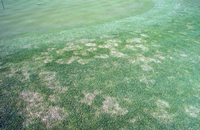
Figure 4 |

Figure 5 |

Figure 6 |
Signs
Although signs of the disease are not visible in the field,
L. terrestris cells are visible microscopically or in mass in culture. Cells can be observed directly in symptomatic grass with a compound microscope if infected leaves are torn lengthwise and mounted in water.
L. terrestris cells should be present along the torn edge inside the leaf (Figure 7), or floating outside the torn edge. Cells are hyaline and spindle shaped or ovoid with tapering ends.
Signs can also be observed by placing infected grass blades and roots on suitable agar media and examining emerging colonies with a stereo microscope.
L. terrestris requires selective media for culturing in vitro. An effective isolation medium contains water agar, 1% horse serum, and diluted seawater (EC=3.5-4.0 dS/m). Colonies of
L. terrestris cells emerging from infected plant tissues appear slimy and appressed to the media surface. When colonies are clumped together they may be mistaken for yeast or bacteria (Figures 8-9). However, when observed closely, actively growing colonies have a characteristic labyrinth, forking, or digitate shape (Figures 8, 9b). Cultures can be viewed with a stereomicroscope using light shining up through the culture (Figure 9b) or with a compound microscope using phase contrast or dark field.
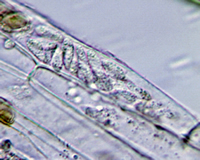
Figure 7 |
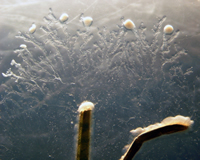
Figure 8 |
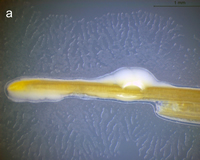
Figure 9a |
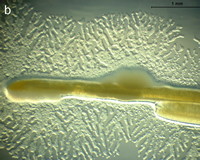
Figure 9b |
Pathogen Biology
Labyrinthula terrestris belongs to the kingdom Chromista, (also called Stramenopile or Straminipila).
Labyrinthula species are classified as stramenopiles, which means "straw hair", referring to the tubular hairs on one of the two zoospore flagella. Zoospores have been observed in only one
Labyrinthula species, but not in
L. terrestris.
The name
Labyrinthula was derived from the labyrinth, or maze-like, appearance of motile cells as they move in ectoplasmic networks (Figures 8-9). This network has a glossy sheen or slimy appearance, thus assigned the common name 'net slime molds'. They are also known as 'marine slime molds', referring to the marine environments from which most species have been isolated. They are not related to the true slime molds, the Myxomycota (kingdom Protozoa), but are grouped separately in the kingdom Chromista as the Labyrinthulomycota.
The known life cycle of
L. terrestris is simple and vegetative; no sexual reproductive cells or structures have been identified. Cells are hyaline, ellipsoid, fusiform or spindle shaped (13.0-17.5 × 4.5-7.0μm), containing a single nucleus, vacuoles, and numerous lipid droplets (Figures 10-12). Cells multiply by dividing longitudinally or obliquely (Figure 12).
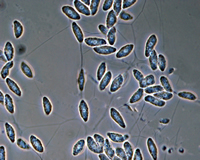
Figure 10 |
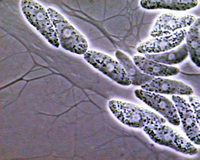
Figure 11 |
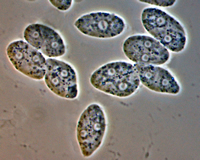
Figure 12 |
Cells move in tubular ectoplasmic networks, also known as slimeways (Figures 10-11), created by a specialized organelle, the bothrosome. In these networks cells move or "glide" at about 3.5 to 9.0 mm h-1 on water agar medium. Two types of movement have been observed in
L. terrestris: (1) translocation of spindle cells gliding within a membrane-bound slimeway laid down recently by other cells in the colony; and (2) extension of slimeways from cells on the advancing edge that allows for colony expansion. These networks branch and anastomose, which gives actively growing colonies their characteristic labyrinth, forking, or digitate shape (Figures 8, 9, 14, 15).
L.terrestris has the capability to move over the surface of plant material, and it is possible that these gliding mechanisms are the means of mobility plant to plant.
In older colonies, cells aggregate into clumps (Figure 16) that appear hyaline to yellow. Cells within the clumps are ovoid and they are not motile; however, the viable, aggregated cells can reinitiate movement via slimeways when placed on a suitable medium. The function of the aggregates is unknown, although they are presumed to be long-term survival structures.
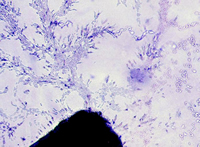
Figure 14 |
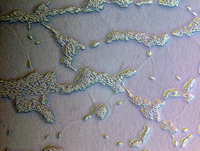
Figure 15 |
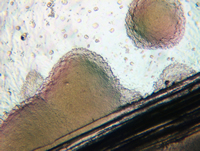
Figure 16 |
Several
Labyrinthula species have been described as saprobes from marine and freshwater environments, the only proven pathogenic species of
Labyrinthula in a marine plant is
L. zosterae.
L. terrestris was described as a distinct species because of its pathogenicity to terrestrial plants, salinity range, cell size and shape, and molecular evidence.
Disease Cycle and Epidemiology
 Figure 17 Disease Cycle
Figure 17 Disease Cycle
Epidemics of rapid blight can be devastating when they occur on high-value turfgrasses such as overseeded golf greens (Figure 6). Epidemics may occur on newly emerged seedlings of cool-season grasses or any time after establishment of grasses. Symptoms of rapid blight in the field have been observed only on cool-season turfgrasses such as rough bluegrass (Poa trivialis), annual bluegrass (Poa annua), perennial ryegrass (Lolium perenne), colonial bentgrass (Agrostis tenuis), creeping bentgrass (Agrostis stolonifera), velvet bentgrass (Agrostis canina), and Chewing's fescue (Festucarubra var. commutata) (Figures 1-6). However, different degrees of disease severity are found among different cool-season turfgrasses. In greenhouse and field trials, rough and annual bluegrasses, colonial and velvet bentgrasses, and certain cultivars of perennial ryegrasses were found to be highly susceptible when salinity of the irrigation water was between 3.5 and 4.5 dS/m. At this level of salinity, rapid blight disease severity was reduced in creeping bentgrass, creeping red fescue (Festuca rubra subsp.
litoralis), and alkaligrass (Puccinellia spp.). However, these more salt-tolerant grass species may still develop rapid blight symptoms under increased salinity conditions.
Hosts other than cool-season turfgrasses, including non-symptomatic warm-season turfgrasses, have been confirmed. An obvious positive relationship between salinity tolerance and disease severity associated with rapid blight has been observed in both warm- and cool-season turfgrasses. Tolerance to drought and salinity varies among these broad groups, but in general cool-season turfgrasses are less tolerant to salinity and damaged more by rapid blight than the warm-season turfgrasses. It should be noted that warm-season grasses such as bermudagrass (Cynodon spp.) and paspalum (Paspalum spp.) with high salinity tolerance are known hosts for
L. terrestris but are not visibly affected by the disease. Currently
L. terrestris is a concern on cool-season turfgrasses, but the gramineous host range for this pathogen is likely to increase as more knowledge about this organism and the disease is accrued.
Environmental conditions that are conducive to rapid blight epidemics are quite different from most turfgrass diseases caused by true fungi or
Pythium spp. Rapid blight occurs over a wide range of temperature (ambient 10-34o C) under field conditions. While foliar turf diseases caused by fungi or
Pythium spp. are most severe when moisture is abundant, rapid blight is less severe under rainy conditions if precipitation is adequate to reduce salinity to levels less conducive to disease development. However, rapid blight can develop when rainfall is lacking for as little as two weeks in the field, and irrigation water has salinity of 1.5 dS/m or above. The higher the salinity of irrigation water, the more quickly the disease can develop if leaching rainfall does not occur. Under drought conditions and high salinity irrigation water (3.5 dS/m or above), the disease is aptly named and can destroy turfgrass stands of susceptible grasses in a week. It should be noted that the disease is promoted not by salinity in the broad sense, but by the amount of sodium cations that contribute to the salinity.
Infection of susceptible grasses may initiate on both leaves and roots. The pathogen is able to spread via roots, and above-ground symptoms have been shown to develop even when infected leaves are not in contact with non-infected leaves. In addition, studies have shown that cells of
L. terrestris can penetrate grass leaf tissue through stomata and wounds such as cut leaves. In infection experiments, plants that were wounded by cutting the leaves with scissors and inoculated with
L. terrestris cells developed symptoms faster than the plants that were not wounded. In the field, spread of the pathogen by mowing as well as foot traffic is suspected (Figure 6). Certainly mower blades and rollers cause wounds that can serve as points of entry, as well as a means of dispersal of
L. terrestris cells. The role of the ectoplasmic network produced in active cultures and on inoculated grass leaves has not been completely elucidated, but it is believed to be involved in nutrition and motility. Microscopic observations reveal that the network adheres to leaf surface features such as such as trichomes and stomata guard cells.
The means of survival by
L. terrestris in plant, soil, or thatch is not known. Dense aggregations of rounded, non-motile cells are formed on leaf blades killed by rapid blight (Figure 16), and in older cultures. Cells within these aggregations have been shown to survive for over a year in culture. It is unknown how these cell aggregations function in nature or how the cells reinitiate growth and production of the ectoplasmic network in the field.
L. terrestris can survive as a saprobe on non-susceptible turfgrasses. For example, it has been re-isolated from small samples of infected perennial ryegrass and
Poa trivialis that were air dried and stored up to six months.
L. terrestris also was isolated from bermudagrass, which appears to be unaffected but is a known host. It was cultured from bermudagrass stolons and rhizomes, in known infested sites and where disease had not been observed, during the hot summer months at golf courses in central Arizona. These observations and experiments indicate that inoculum may be present in asymptomatic warm-season turfgrass tissues as well as in dead cool-season grass tissues. Advances in research on the biology of
L. terrestris and the rapid blight pathosystem will potentially pave the way for development of more effective rapid blight management strategies.
Disease Management
An integrated management of rapid blight disease involves manipulation of host, pathogen, and environmental conditions. One strategy involving host manipulation is the use of more tolerant cool-season grasses in both perennial and seasonal overseeded sites. However, if epidemics occur in late fall or winter, re-establishment by seed can be difficult or impossible due to the slow rate of seed germination in cold temperatures and seed germination inhibition by persisting salinity problems. Where rapid blight is chronic and severe, the most practical choice may be to stop overseeding altogether. In the southeastern United States, many golf turf managers are no longer overseeding putting greens with cool-season grasses. Instead, they are providing winter color with paints or pigments. More tolerant species and cultivars may be used if a turf manager must use cool-season grasses. An example is slender creeping red fescue which may be mixed with a more susceptible but quickly germinating species such as perennial ryegrasses. It should be noted that the red fescues are very slow in germination and establishment, and they do not provide a benefit if epidemics occur early in establishment of the ryegrass component. Also, smaller seeded tolerant grasses such as alkaligra
ss may be mixed with more susceptible
Poa trivialis cultivars or used as a single species for overseeding putting greens, although its appearance and slower germination make it less desirable as a single component in overseeded grass.
Manipulation of environmental conditions is addressed by strategies to reduce salinity in irrigation water and soil. A very effective way to control rapid blight is to reduce salinity by leaching soil with less saline water. It has been frequently observed that rainfall may reduce or eliminate a rapid blight epidemic. When adequate rains do not occur, soil salinity may be reduced if alternative sources of water are available or if saline soils can be leached with an excess leaching fraction. Application of calcium sources such as gypsum to reduce sodium in the soil may reduce severity of the disease, but it may not provide complete control. The effectiveness of leaching and use of gypsum to displace sodium relies on adequate internal drainage to move displaced sodium from the root zone. Besides promoting rapid blight, sodium also has detrimental effects on soil structure and sodium-affected soils typically exhibit poor drainage due to deflocculation of organic matter and clay colloids. On golf greens affected by rapid blight, disease development on turf around aerification holes appears to be slower than those in the area where surface drainage is impeded. Sodium can also be removed from irrigation water by use of reverse osmosis systems, where they are affordable and permissible. This is an extremely expensive but effective way to eliminate excess salinity from irrigation water and thereby control the disease and avoid other detrimental effects of salinity.
Options are more limited to manipulate the pathogen directly. Only a few fungicides, such as pyraclostrobin, trifloxystrobin, and mancozeb, are effective in controlling rapid blight. Mancozeb and trifloxystobin alone or in a mixture can provide moderate suppression of the disease for two to three weeks. The most effective suppression has been provided by pyraclostrobin or the mixture of pyraclostrobin and mancozeb. On the contrary, very little control has been achieved with azoxystrobin, which has the same mode of action as other effective strobilurin fungicides. It should be noted that under high disease pressure, rapid blight may overcome the effectiveness of a fungicide.
Significance
It is probable that
L. terrestris is well established as a terrestrial inhabitant but has been overlooked because of a selective medium necessary to isolate the organism. Its emergence as a pathogen of turfgrass may coincide with the increased acreage of turf and changes in cultural practices such as increased use of relatively high salinity water, reclaimed water for irrigation, increased frequency of mowing, and decreased mowing heights. As an important emerging pathogen of turfgrass,
L. terrestris poses a potential problem in susceptible turfgrass varieties wherever soil salinity increases as a result of poor soil structure or suboptimal irrigation water.
Selected References
Bigelow, D.M., M.W. Olsen, and R.L. Gilbertson. 2005. Labyrinthula terrestris sp. nov. a new turfgrass pathogen. Mycologia 97:185-190.
Camberato, J.J., P.D. Peterson, and S.B. Martin. 2006. Salinity and salinity tolerance alter rapid blight in Kentucky bluegrass, perennial ryegrass, and slender creeping red fescue. Applied Turfgrass Science, doi:10.1094/ATS-2006-0213-01-RS.
Cienkowski, L. 1867. Ueber den Bau und die Entwicklung der Labyrinthuleen. Archiv fur Mikroskopische Anatomie 3:274-310.
Craven, K.D., P.D. Peterson, D.E. Windham, T.K. Mitchell, and S.B. Martin. 2005. Molecular identification of the turf grass rapid blight pathogen. Mycologia 97:163-169.
Dick, M.W. 2001. Straminipilous Fungi: Systematics of the Peronosporomycetes including accounts of the marine straminipilous protists, the plasmodiophorids and similar organisms Kluwer Academic, Dordrecht, Boston and London, 670 pp.
Douhan, G.W., M.W. Olsen, A. Herrell, C. Winder, F. Wong, and K. Entwistle. 2009. Genetic diversity of Labyrinthula terrestris, a newly emergent plant pathogen, and the discovery of new Labyrinthulid organisms. Mycological Research 113:1192-1199.
Entwistle, C.A., M.W. Olsen, and D.M. Bigelow. 2005. First report of a Labyrinthula spp. causing rapid blight of Agrostis capillaris and Poa annua on amenity turfgrass in the UK. New Disease Reports, British Society for Plant Pathology, April 2005.
Kopec, D., M.W. Olsen, J. Gilbert, D.M. Bigelow, M. Kohout. 2004. Cool-season grass response to rapid blight disease. Golf Course Management Magazine, Research, GCSAA, Lawrence, KS, December 2004:78-81.
Liu, C., J.J. Camberato, S.B. Martin, and A. Turner. 2001. Rough bluegrass germination varies with temperature and cultivar/seed lot. HortScience 36:153‑156.
Muehlstein, L.K., D. Porter, and F.T. Short. 1988. Labyrinthula sp., a marine slime mold producing the symptoms of wasting disease in eelgrass, Zostera marina. Marine Biology 99:465-472.
Muehlstein, L.K. and D. Porter. 1991. Labyrinthula zosterae sp. nov., the causative agent of wasting disease of eelgrass, Zostera marina. Mycologia 83:180-191.
Nakatsuji, N. and E. Bell. 1980. Control by calcium of the contractility of Labyrinthula slimeways and of the translocation of cells. Cell Motility 1:17-29.
Olsen, M.W., D.M. Bigelow, R.L. Gilbertson, L.J. Stowell, and W.D. Gelernter. 2003. First report of a Labyrinthula sp. causing rapid blight disease of rough bluegrass and perennial ryegrass. Plant Disease 87:1267.
Olsen, M.W. and M.J. Kohout. 2006. Isolation of the rapid blight pathogen, Labyrinthula terrestris, from bermudagrass in Arizona, Super Journal of PACE Turfgrass Research online publication: http://www.paceturf.org/PTRI/Documents/051121sj.pdf.
Olsen, M.W., D. Kopec, and J. Gilbert. 2011. Turfgrasses evaluated for tolerance to rapid blight. Golf Course Management Magazine, Research, GCSAA, Lawrence, KS, July 2011:86-88.
Patterson, D.J. 1989. Stramenopiles: chromophytes from a protistan perspective. Pages 357-379 in: The Chromophyte Algae Problems and Perspectives. J.C. Green, B.S.C. Leadbeater, and W.L. Diver, eds., Clarendon Press, Oxford.
Peterson, P.D., S.B. Martin, and J.J. Camberato. 2005. Tolerance of cool-season turfgrasses to rapid blight disease. Online, Turfgrass Science doi:10.1094/ATS-2005-0328-01-RS.
Porter, D. 1972. Cell division in the marine slime mold, Labyrinthula sp., and the role of the bothrosome in extracellular membrane production. Protoplasma 74:427-448.
Preston, T.M., and C.A. King. 2005. Actin-based motility in the net slime mould Labyrinthula: evidence for the role of myosin in gliding movement. Journal of Eukaryotic Microbiology 52:461–475.
Stowell, L.J., S.B. Martin, M.W. Olsen, D.M. Bigelow, M. Kohout, P.D. Peterson, J. Camberato, and W.D. Gelernter. 2005. Rapid blight: a new plant disease. APS Feature Article, July 2005, http://www.apsnet.org/online/feature/rapid/.
Young, E.L. 1943. Studies on Labyrinthula the etiologic agent of the wasting disease of eel-grass. American Journal of Botany 30:586-593.
